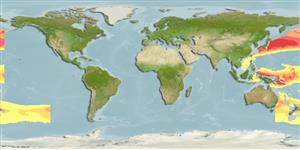klasifikasi / Names
Nama-nama umum | Sinonim (persamaan) | Catalog of Fishes(Marga, Jenis) | ITIS | CoL | WoRMS | Cloffa
>
Scombriformes (Mackerels) >
Chiasmodontidae (Snaketooth fishes)
Etymology: Chiasmodon: Name from the Greek 'chiasmos' which means diagonally arranged, and 'odous' for tooth or teeth.; pluriradiatus: Named for Robert James Lavenberg, American ichthyologist..
Environment: milieu / climate zone / depth range / distribution range
Ekologi
laut; kisaran kedalaman 230 - 1600 m (Ref. 82429). Deep-water
Atlantic, Indian, Southest Pacific, tropical Atlantic and Gulf of Mexico, from 32°N-11°S, 20°W-77°W; in the western Indian from 12°S-32°S, 60°W-58°E; in the southern Pacific from 25°S-38°S, 167°W-179°E
Size / Weight / umur
Maturity: Lm ? range ? - ? cm
Max length : 22.1 cm SL jantan/; (Ref. 82429)
deskripsi pendek
Morfologi | Morfometrik
vertebrata, bertulang belakang: 44 - 45. This species is distinguished from its congeners by the number of pectoral-fin rays 15-16 (vs. 12-14); fangs on premaxillary head 2 (vs. 1); with tiny dermal spinules on body of specimens larger than 48.7 mm present (vs. absent); it further differs from C. asper by supraorbital canal pores 8 (vs. 9) (Ref. 82429).
Found in the meso- to bathypelagic zones, with adults more frequently collected below 900 m (Ref. 82429).
Life cycle and mating behavior
Kematangan | Reproduksi, perkembang biakan | Pemijahan | telur-telur | Fecundity | Larva
Prokofiev, A.M., 2008. Two new species of swallowerfishes of the genera Chaismodon and Kali (Chiasmodontidae). J. Ichthyol. 48(3):209-216. (Ref. 76904)
Status IUCN Red List (Ref. 130435)
ancaman kepada manusia
Harmless
penggunaan manusia
informasi lanjut
Nama-nama umumSinonim (persamaan)metabolismePemangsaEkotoksikologiReproduksi, perkembang biakanKematanganPemijahanSpawning aggregationFecunditytelur-telurpekembangan telor
Umur / SaizPertumbuhanpanjang-beratpanjang-panjangukuran frekuensiMorfometrikMorfologiLarvaDinamika larvapemulihanKelimpahanBRUVS
AcuanBudidaya airprofil budidaya airStrainGenetikaElectrophoresesDiturunkanPenyakit-penyakitPengolahanNutrientsMass conversion
mitraGambarStamps, Coins Misc.Suara-suaraCiguateraKecepatanTipe renangArea insangOtolithsOtakPenglihatan / visi
Alat, peralatan
laporan khas
muat turun XML
Sumber internet
Estimates based on models
Phylogenetic diversity index (Ref.
82804): PD
50 = 0.5078 [Uniqueness, from 0.5 = low to 2.0 = high].
Bayesian length-weight: a=0.01096 (0.00410 - 0.02933), b=3.03 (2.80 - 3.26), in cm total length, based on LWR estimates for this (Sub)family-body shape (Ref.
93245).
Trophic level (Ref.
69278): 3.8 ±0.2 se; based on size and trophs of closest relatives
Fishing Vulnerability (Ref.
59153): Low vulnerability (17 of 100).
